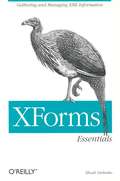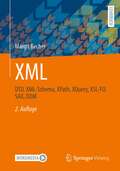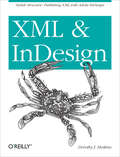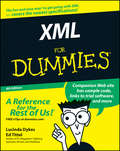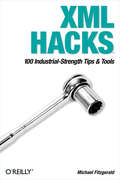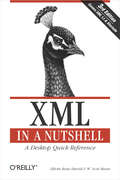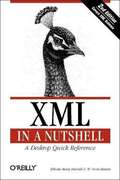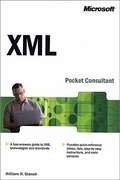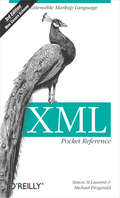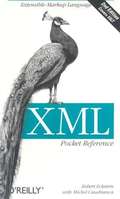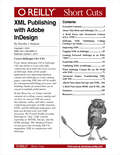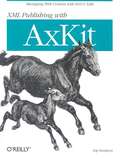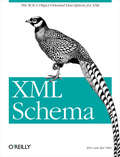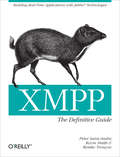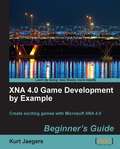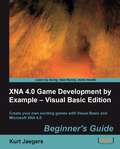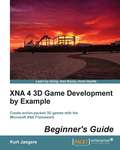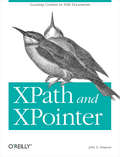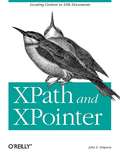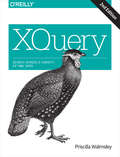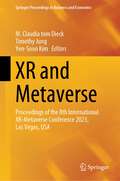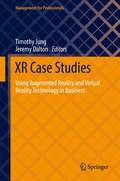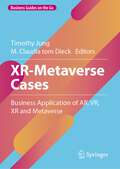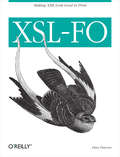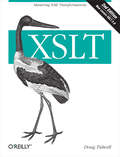- Table View
- List View
XForms Essentials
by Micah DubinkoXForms Essentials is an introduction and practical guide to the new XForms specification. Written by Micah Dubinko, a member of the W3C XForms working group and an editor of the specification, the book explains the how and why of XForms, showing readers how to take advantage of them without having to write their own code. You'll learn how to integrate XForms with both HTML and XML vocabularies, and how XForms can simplify the connection between client-based user input and server-based processing. If you work with forms, HTML, or XML information, XForms Essentials will provide you with a much simpler route to more sophisticated interactions with users.
XML: DTD, XML-Schema, XPath, XQuery, XSL-FO, SAX, DOM
by Margit BecherDie Bedeutung von XML für eine Layout-unabhängige Beschreibung von Dokumenten und damit als Ausgangsformat für Single-Source-Publishing sowie als Austauschformat beim elektronischen Datenaustausch ist heute unstrittig. Anhand vieler Beispiele lernen Sie, wie mit den Sprachen DTD und XML-Schema eigene Auszeichnungssprachen definiert werden können. Ein weiterer Schwerpunkt dieses Buches bildet eine fundierte Einführung in Technologien zur Weiterverarbeitung von XML: XPath, XQuery und XSLT.
XML and InDesign: Stylish Structure: Publishing XML with Adobe InDesign
by Dorothy J. HoskinsFrom Adobe InDesign CS2 to InDesign CS5, the ability to work with XML content has been built into every version of InDesign. Some of the useful applications are importing database content into InDesign to create catalog pages, exporting XML that will be useful for subsequent publishing processes, and building chunks of content that can be reused in multiple publications. New coverage includes Export in XML order for EPUB (CS5.5 and later) and some new code examples for that process, perhaps some sample GREP to map content to XML, and strategies and settings for the export to EPUB.
XML For Dummies
by Ed Tittel Lucinda DykesSee how XML works for business needs and RSS feedsCreate consistency on the Web, or tag your data for different purposesTag -- XML is it! XML tags let you share your format as well as your data, and this handy guide will show you how. You'll soon be using this markup language to create everything from Web sites to business forms, discovering schemas and DOCTYPES, wandering the Xpath, teaming up XML with Office 2003, and more.Discover how to* Make information portable* Use XML with Word 2003* Store different types of data* Convert HTML documents to XHTML* Add CSS to XML* Understand and use DTDs
XML Hacks
by Michael FitzgeraldDevelopers and system administrators alike are uncovering the true power of XML, the Extensible Markup Language that enables data to be sent over the Internet from one computer platform to another or one application to another and retain its original format. Flexible enough to be customized for applications as diverse as web sites, electronic data interchange, voice mail systems, wireless devices, web services, and more, XML is quickly becoming ubiquitous. XML Hacks is a roll-up-your-sleeves guide that distills years of ingenious XML hacking into a complete set of practical tips, tricks, and tools for web developers, system administrators, and programmers who want to go far beyond basic tutorials to leverage the untapped power of XML. With plenty of useful real-world projects that illustrate how to define, read, create, and manipulate XML documents, XML Hacks shows readers how to put XML's power to work on the Internet and within productivity applications. Each Hack in this book can be read easily in a few minutes, saving programmers and administrators countless hours of searching for the right answer. And this is an O'Reilly Hacks book, so it's not just practical, imminently useful, and time-saving. It's also fun. From Anatomy of an XML Document to Exploring SOAP Messages XML Hacks shows you how to save time and accomplish more with fewer resources. If you want much more than the average XML user--to explore and experiment, do things you didn't know you could do with XML, discover clever shortcuts, and show off just a little--this invaluable book is a must-have.
XML in a Nutshell
by Elliotte Rusty Harold W. Scott MeansIf you're a developer working with XML, you know there's a lot to know about XML, and the XML space is evolving almost moment by moment. But you don't need to commit every XML syntax, API, or XSLT transformation to memory; you only need to know where to find it. And if it's a detail that has to do with XML or its companion standards, you'll find it--clear, concise, useful, and well-organized--in the updated third edition of XML in a Nutshell. With XML in a Nutshell beside your keyboard, you'll be able to: Quick-reference syntax rules and usage examples for the core XML technologies, including XML, DTDs, Xpath, XSLT, SAX, and DOM Develop an understanding of well-formed XML, DTDs, namespaces, Unicode, and W3C XML Schema Gain a working knowledge of key technologies used for narrative XML documents such as web pages, books, and articles technologies like XSLT, Xpath, Xlink, Xpointer, CSS, and XSL-FO Build data-intensive XML applicationsUnderstand the tools and APIs necessary to build data-intensive XML applications and process XML documents, including the event-based Simple API for XML (SAX2) and the tree-oriented Document Object Model (DOM) This powerful new edition is the comprehensive XML reference. Serious users of XML will find coverage on just about everything they need, from fundamental syntax rules, to details of DTD and XML Schema creation, to XSLT transformations, to APIs used for processing XML documents. XML in a Nutshell also covers XML 1.1, as well as updates to SAX2 and DOM Level 3 coverage. If you need explanation of how a technology works, or just need to quickly find the precise syntax for a particular piece, XML in a Nutshell puts the information at your fingertips. Simply put, XML in a Nutshell is the critical, must-have reference for any XML developer.
XML in a Nutshell, 2nd Edition
by Elliotte Rusty Harold W. Scott MeansThis powerful new edition provides developers with a comprehensive guide to the rapidly evolving XML space. Serious users of XML will find topics on just about everything they need, from fundamental syntax rules, to details of DTD and XML Schema creation, to XSLT transformations, to APIs used for processing XML documents. Simply put, this is the only reference of its kind among XML books.
XML Pocket Consultant
by William R. StanekBuild and support dynamic, Web-enabled documents with this indispensable guide to XML. This pocket-sized resource zeroes in on the latest XML standards and technologies, including Extensible Stylesheet Language (XSL), XML schemas, XLink, and XPath--delivering critical details through quick-reference tables, step-by-step instructions, lists, and code samples. It's the precise information you need to solve problems and get the job done--no matter what kind of content you want to get on line! GET FAST FACTS TO: Understand XML fundamentals, including naming rules Describe data structure using DTDs Achieve greater power and flexibility with XML schemas Get at-a-glance reference to schema declarations Use namespaces to avoid naming conflicts Create rich formatting with XSL stylesheets Build links to and extract database information Structure XML data dynamically using XSL Transformations and XPath Create hypertext references with XLink and XPointer
XML Pocket Reference: Extensible Markup Language (Pocket Reference (O'Reilly))
by Simon St. Laurent Michael FitzgeraldXML, the Extensible Markup Language, is everywhere: the syntax of choice for newly designed document formats across almost all computer applications. Now used daily by developers, XML is living up to its reputation as one of the most important developments in document interchange in the history of computing. A perennial bestseller, the handy XML Pocket Reference from O'Reilly has been revised once again to give you quick access to the latest goods. In addition to its comprehensive look at XML, this third edition has been updated with new material on Namespaces and XML Schema--considered among the most important elements in current XML use--along with RELAX NG and Schematron, additional powerful tools for describing XML document structures. Like other titles in O'Reilly's Pocket Reference series, the XML Pocket Reference, 3rd Edition features a well-organized format that gets right to the point. As a result, it's already won over the allegiance of developers everywhere. If you need XML answers quick and on the fly, this compact book is most definitely the book for you.
XML Pocket Reference, 2nd Edition
by Robert EcksteinThe XML Pocket Referenceis both a handy introduction to XML terminology and syntax, and a quick reference to XML instructions, attributes, entities, and datatypes. Although XML itself is complex, its basic concepts are simple. This small book combines a perfect tutorial for learning the basics of XML with a reference to the XML and XSL specifications. The new edition introduces information on XSLT (Extensible Stylesheet Language Transformations) and Xpath.
XML Publishing with Adobe InDesign
by Dorothy HoskinsFrom Adobe InDesign CS2 to InDesign CS5, the ability to work with XML content has been built into every version of InDesign. Some of the useful applications are importing database content into InDesign to create catalog pages, exporting XML that will be useful for subsequent publishing processes, and building chunks of content that can be reused in multiple publications. In this Short Cut, we'll play with the contents of a college course catalog and see how we can use XML for course descriptions, tables, and other content. Underlying principles of XML structure, DTDs, and the InDesign namespace will help you develop your own XML processes. We'll touch briefly on using InDesign to "skin" XML content, exporting as XHTML, InCopy, and the IDML package. The Advanced Topics section gives tips on using XSLT to manipulate XML in conjunction with InDesign.
XML Publishing with AxKit
by Kip HamptonWeb developers rely on XML to separate data from presentation and create a consistent templating system for a web site. Although limited XML-to-HTML conversion is possible within some browsers, web developers creating dynamic or complex sites will find server-side XML transformation a necessity. Unfortunately, until recently, there have been few XML tools available for server-side XML transformation or authoring. AxKit, a mod_perl and Apache-based XML content delivery solution, was designed to meet that need with a cost-effective and efficient plugin architecture. AxKit allows the developer to quickly design modules to create faster web sites, and deliver them in a wide variety of media formats. AxKit also takes care of caching so the developer doesn't have to worry about it. AxKit meets the demands of the web developer nicely, but, as with any new toolkit, there is a learning curve. For developers who want to flatten that learning curve and get right to work with AxKit, XML Publishing with AxKit provides detailed information on how to install, configure, and deploy AxKit effectively. The first book solely devoted to AxKit, XML Publishing with AxKit also offers a concise and focused look at how to create XSLT and XPathScript-based pipelines for XML data transfer. This solidly useful new book presents web programmers with the hands-on knowledge they need to get really creative with AxKit. It features a thorough introduction to XSP (extensible Server Pages), which applies the concepts of Server Pages technologies (embedded code, tag libraries, etc) to the XML world, and covers integrating AxKit with other tools such as Template Toolkit, Apache:: Mason, Apache::ASP, and plain CGI. The book also includes invaluable reference sections on configuration directives, XPathScript, and XSP. With XML Publishing with AxKit , web developers will have all the tools they need to deliver complex XML-based systems quickly, the power to develop their own systems for style sheet negotiation, and the flexibility to design completely new style sheet languages. XML Publishing with AxKit gives those new to XML all the background and the courage they need to jump right in and deploy AxKit. And it gives XML-savvy professionals everything they need to hit the ground running.
XML Schema
by Eric van der VlistIf you need to create or use formal descriptions of XML vocabularies, the W3C's XML Schema offers a powerful set of tools for defining acceptable document structures and content. An alternative to DTDs as the way to describe and validate data in an XML environment, XML Schema enables developers to create precise descriptions with a richer set of datatypes?such as booleans, numbers, currencies, dates and times?that are essential for today?s applications. Schemas are powerful, but that power comes with substantial complexity. This concise book explains the ins and outs of XML Schema, including design choices, best practices, and limitations. Particularly valuable are discussions of how the type structures fit with existing database and object-oriented program contexts. With XML Schema, you can define acceptable content models and annotate those models with additional type information, making them more readily bound to programs and objects. Schemas combine the easy interchange of text-based XML with the more stringent requirements of data exchange, and make it easier to validate documents based on namespaces. You?ll find plenty of examples in this book that demonstrate the details necessary for precise vocabulary definitions. Topics include: Foundations of XML Schema syntax Flat, "russian-doll", and other schema approaches Working with simple and complex types in a variety of contexts The built-in datatypes provided by XML Schema Using facets to extend datatypes, including regular expression-based patterns Using keys and uniqueness rules to limit how and where information may appear Creating extensible schemas and managing extensibility Documenting schemas and extending XML Schema capabilities through annotations In addition to the explanatory content, XML Schemaprovides a complete reference to all parts of both the XML Schema Structures and XML Schema Datatypes specifications, as well as a glossary. Appendices explore the relationships between XML Schema and other tools for describing document structures, including DTDs, RELAX NG, and Schematron, as well as work in progress at the W3C to more tightly integrate XML Schema with existing specifications. No matter how you intend to use XML Schema - for data structures or document structures, for standalone documents or part of SOAP transactions, for documentation, validation, or data binding ? all the foundations you need are outlined in XML Schema.
XMPP: Building Real-Time Applications with Jabber Technologies
by Peter Saint-Andre Kevin Smith Remko TronçonThis practical book provides everything you need to know about the Extensible Messaging and Presence Protocol (XMPP). This open technology for real-time communication is used in many diverse applications such as instant messaging, Voice over IP, real-time collaboration, social networking, microblogging, lightweight middleware, cloud computing, and more. XMPP: The Definitive Guide walks you through the thought processes and design decisions involved in building a complete XMPP-enabled application, and adding real-time interfaces to existing applications. You'll not only learn simple yet powerful XMPP tools, but you'll also discover, through real-world developer stories, how common XMPP "building blocks" can help solve particular classes of problems. With this book, you will: Learn the basics of XMPP technologies, including architectural issues, addressing, and communication primitives Understand the terminology of XMPP and learn about the wealth of XMPP servers, clients, and code libraries Become familiar with the XMPP concepts and services you need to solve common problems Construct a complete business application or real-time service with XMPP Every day, more software developers and service providers are using XMPP for real-time applications, and with the help of XMPP: The Definitive Guide, you can, too.
XNA 4.0 Game Development by Example: Beginner's Guide
by Kurt JaegersThis book is a step-by-step tutorial that includes complete source code for all of the games covered. It adopts an engaging style to teach all the game development concepts. Each block of code is explained, and game development concepts are diagrammed and covered in detail. Each game begins with a concept description and concludes with suggestions for expanding on the finished game. If you are an aspiring game developer who wants to take a shot at creating games for the Microsoft Windows platform with the XNA Framework, then this book is for you. Using this book, you can get started with creating games without any game development experience. A basic knowledge of C# would be helpful to kick-start your game development, but it's not essential.
XNA 4.0 Game Development by Example: Beginner's Guide – Visual Basic Edition
by Kurt JaegersThis book is a step-by-step tutorial that includes complete source code for all of the games covered. It adopts an engaging style to teach all the game development concepts. Each block of code is explained, and game development concepts are diagrammed and covered in detail. Each game begins with a concept description and concludes with suggestions for expanding on the finished game. If you are an aspiring game developer who wants to take a shot at creating games for the Microsoft Windows platform with the XNA Framework, then this book is for you. Using this book, you can get started with creating games without any game development experience. A basic knowledge of Visual Basic would be needed to kickstart your game development.
XNA 4 3D Game Development by Example: Beginner's Guide
by Kurt JaegersThis book is a step-by-step tutorial that includes complete source code for all of the games covered. It adopts an engaging style to teach all the game development concepts. Each block of code is explained, and game development concepts are diagrammed and covered in detail. Each game begins with a concept description and concludes with suggestions for expanding on the finished game. This book is intended for readers who want to create 3D games using the XNA Framework. Basic knowledge of the C# programming language and 2D XNA concepts are helpful, but not required.
XPath and XPointer
by John SimpsonReferring to specific information inside an XML document is a little like finding a needle in a haystack: how do you differentiate the information you need from everything else? XPath and XPointer are two closely related languages that play a key role in XML processing by allowing developers to find these needles and manipulate embedded information. XPath describes a route for finding specific items by defining a path through the hierarchy of an XML document, abstracting only the information that's relevant for identifying the data. XPointer extends XPath to identify more complex parts of documents. The two technologies are critical for developers seeking needles in haystacks in various types of processing. XPath and XPointer fills an essential need for XML developers by focusing directly on a critical topic that has been covered only briefly. Written by John Simpson, an author with considerable XML experience, the book offers practical knowledge of the two languages that underpin XML, XSLT and XLink. XPath and XPointer cuts through basic theory and provides real-world examples that you can use right away. Written for XML and XSLT developers and anyone else who needs to address information in XML documents, the book assumes a working knowledge of XML and XSLT. It begins with an introduction to XPath basics. You'll learn about location steps and paths, XPath functions and numeric operators. Once you've covered XPath in depth, you'll move on to XPointer--its background, syntax, and forms of addressing. By the time you've finished the book, you'll know how to construct a full XPointer (one that uses an XPath location path to address document content) and completely understand both the XPath and XPointer features it uses. XPath and XPointer contains material on the forthcoming XPath 2.0 spec and EXSLT extensions, as well as versions 1.0 of both XPath and XPointer. A succinct but thorough hands-on guide, no other book on the market provides comprehensive information on these two key XML technologies in one place.
XPath and XPointer
by John E. SimpsonReferring to specific information inside an XML document is a little like finding a needle in a haystack. XPath and XPointer are two closely related languages that play a key role in XML processing by allowing developers to find these needles and manipulate embedded information. By the time you've finished XPath and XPointer , you'll know how to construct a full XPointer (one that uses an XPath location path to address document content) and completely understand both the XPath and XPointer features it uses.
XQuery
by Priscilla Walmsley<p><em>XQuery</em> delivers a carefully paced tutorial that goes into the final 1.0 standard in detail. The book delves into critical advanced issues such as data typing and designing efficient query logic. Whether you're coming from SQL, XSLT, or starting from scratch, you'll learn about XQuery's support for filtering, sorting, and grouping data, as well as how to use FLWR expressions, XPath, and XQuery tools for extracting and combining information.</p>
XR and Metaverse: Proceedings of the 8th International XR-Metaverse Conference 2023, Las Vegas, USA (Springer Proceedings in Business and Economics)
by M. Claudia tom Dieck Timothy Jung Yen-Soon KimThis book offers a comprehensive collection of the latest research presented at the 8th International XR-Metaverse Conference, held in Las Vegas, USA in 2023. Its goal is to bridge the gap between academia and industry by advancing the state of the art in metaverse, XR, AI-based AR and VR technologies, and by exploring their applications in various fields such as business, marketing, education, health care, tourism, events, fashion, entertainment, retail, and the gaming industry. Including contributions by prominent XR scholars from around the globe, the book addresses a wide range of significant topics concerning XR and the metaverse. Showcasing cutting-edge research outputs, it will be of interest to both academics and practitioners eager to catch up on the latest developments in this rapidly evolving field.
XR Case Studies: Using Augmented Reality and Virtual Reality Technology in Business (Management for Professionals)
by Timothy Jung Jeremy DaltonThis book presents a comprehensive collection of case studies on augmented reality and virtual realty (AR/VR) applications in various industries. Augmented reality and virtual reality are changing the business landscape, providing opportunities for businesses to offer unique services and experiences to their customers. The case studies provided in this volume explore business uses of the technology across multiple industries such as healthcare, tourism, hospitality, events, fashion, entertainment, retail, education and video gaming. The book includes solutions of different maturities as well as those from startups to large enterprises thereby providing a thorough view of how augmented reality and virtual reality can be used in business.
XR-Metaverse Cases: Business Application of AR, VR, XR and Metaverse (Business Guides on the Go)
by Timothy Jung M. Claudia tom DieckThis book presents a collection of latest case studies on augmented reality (AR) and virtual reality (VR), extended reality (XR) and metaverse applications in various industries. AR, VR, XR and Metaverse are changing the business landscape, providing opportunities for businesses to offer unique services and experiences to their customers. The case studies explore business uses of the technology across multiple industries such as healthcare, tourism, hospitality, events, fashion, entertainment, retail, education and video gaming. The volume includes solutions of different maturities as well as those from startups to large enterprises thereby providing a thorough view of how AR, VR, XR and Metaverse can be used in business.
XSL-FO: Making XML Look Good in Print
by Dave PawsonExtensible Style Language-Formatting Objects, or XSL-FO, is a set of tools developers and web designers use to describe page printouts of their XML (including XHTML) documents. XSL-FO teaches you how to think about the formatting of your documents and guides you through the questions you'll need to ask to ensure that your printed documents meet the same high standards as your computer-generated content.
XSLT
by Doug TidwellAfter years of anticipation and delay, the W3C finally released the XSLT 2.0 standard in January 2007. The revised edition of this classic book offers practical, real-world examples that demonstrate how you can apply XSLT stylesheets to XML data using either the new specification, or the older XSLT 1.0 standard. XSLT is a critical language for converting XML documents into other formats, such as HTML code or a PDF file. With XSLT, you get a thorough understanding of XSLT and XPath and their relationship to other web standards, along with recommendations for a honed toolkit in an open platform-neutral, standards-based environment. This book:Covers the XSLT basics, including simple stylesheets and methods for setting up transformation engines Walks you through the many parts of XSLT, particularly XSLT's template-based approach to transformations Applies both XSLT 1.0 and 2.0 solutions to the same problems, helping you decide which version of XSLT is more appropriate for your project Includes profuse examples that complement both the tutorial and the reference material The new edition of XSLT has been updated thoroughly to explain XSLT 2.0's many dependencies, notably XML Schema and XPath 2.0. Want to find out how the 2.0 specification improves on the old? This book will explain.
